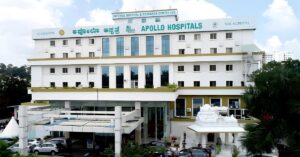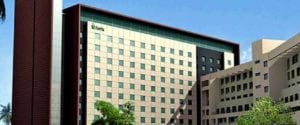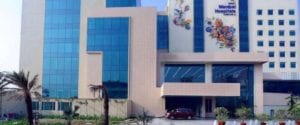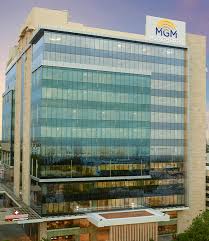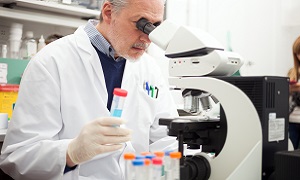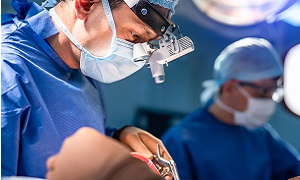Best Doctors in India for Ruptured Eardrum Treatment
Best Hospitals in India for Ruptured Eardrum Treatment
Hospital Highlights:
- Apollo Hospitals is a private healthcare group in India, with its headquarters based in Chennai. Established in 1983 by Dr. Prathap C. Reddy, the group offers a wide range of medical treatments and services across various specialties.
- It is renowned for emphasizing innovation and utilizing cutting-edge medical technologies into patient treatment.
- Known as India’s first corporate hospital, Apollo Hospitals is often credited for pioneering the private healthcare revolution in the country.
- With clinics and hospitals located all throughout India, Apollo Hospitals is a nationwide healthcare organization. Its presence can also be found in foreign countries.
- Preventive health examinations, medical and surgical treatment, and diagnostic centres are just a few of the services that the Apollo group provides.
- The group has several centres of expertise, including Cardiac Sciences, Neurosciences, Orthopedics, Emergency Care, Cancer Care, and Organ Transplantation.
- City: Chennai, India
Hospital Highlights:
- RIMC is a multi-specialty hospital in a sprawling area of 36 acres located in Chromepet, Chennai, Tamil Nadu, India.
- The facility has 450 beds including 130 critical care beds, 9 operating rooms, modern reference laboratories and radiology services, and is conveniently located near road, rail and air transportation.
- RIMC is led and managed by world-renowned physicians committed to healthcare.
- RIMC offers the broadest range of clinical care, education, and research. The hospital offers state-of-the-art technology and modern treatment facilities designed to provide health care at an affordable cost.
- Rela Institute is driven by patient needs, comfort and confidence.
- City: New Delhi, India
Hospital Highlights:
- Fortis Hospital in Shalimar Bagh is a multi-super specialty hospital that strives to provide world-class patient care by leaving no stone unturned.
- Fortis, Shalimar Bagh, with 262 beds and a 7.34-acre footprint, provides the best level of medical care through its team of doctors, nurses, technicians, and management professionals.
- City: Bengaluru, India
Hospital Highlights:
- Established in 2007, the Apollo Hospitals Bangalore is a 300-bed multispecialty hospital situated in Bannerghatta Road, Bangalore.
- Equipped with the state-of-the-art technology, it is a leading hospital dedicated to providing healthcare needs to patients with compassion and expertise.
- It is the first hospital to have completed the highest number of Robot Assisted Heart Surgeries in India.
- Over the years, it has successfully conducted some of the rarest medical procedures such as spinal angiolipoma excision, autologous chondrocyte implantations, and tibial tuberosity shift with MPSL reconstruction.
- The Apollo Hospitals Bangalore has the reputation of performing the greatest series of airway stents in the country.
- Additionally, the hospital is known for providing comprehensive treatment in specialties such as gastroenterology, urology, gynecology, oncology, colorectal surgery, etc.
- The “The Minimal Access Surgery Centre” (MASC), one of Apollo Hospitals, Bangalore’s premier Centres of Excellence, is devoted to the use of minimally invasive surgical procedures.
- In 2013, THE WEEK-A C Nielsen, Best Hospital Survey ranked Apollo Hospitals Bangalore as the 2nd best multi-speciality hospital in Bangalore.
- City: Mumbai, India
Hospital Highlights:
- Gleneagles Global Hospital The 450-bed facility comprises of 17-stories, housing state-of-the-art infrastructure, and advanced medical care facilities.
- The hospital offers end-to-end clinical, surgical, and diagnostic services. It is equipped with a team of eminent medical professionals aided by qualified nurses and medical staff
- The Hospital offers advanced Endoscopic procedures, Hepatobiliary and Liver Surgeries, Surgical and Medical Gastroenterology, Bariatric Surgery, and Robotic surgery.
- The hospital is a center of excellence for Orthopedics, Joint Replacement, Knee Replacement, and Hip Replacement surgery.
- City: Hyderabad, India
Hospital Highlights:
- CARE Hospitals were established in the year 2000, by CARE Group.
- The multispecialty hospital has 435 beds, including 120 critical care beds, with an annual inflow of 180000 outpatients and 16,000 in-patients.
- The hospital provides specialty medical services in Cardiology, Cardiothoracic Surgery, Pediatric Cardiology, Pediatric Cardiothoracic Surgery, Neurology, Neurosurgery, Nephrology, and Urology.
- The hospital has the first dual source, 128 slice CT scanner (for high precision cardiac imaging) – the first of its kind in south India.
- The hospital offers a wide range of accommodation facilities for the convenience of its varied patient base, ranging from general wards to super deluxe rooms.
- City: Mumbai, India
Hospital Highlights:
- Fortis Hospital in Mulund is a 315-bed multi-speciality tertiary care hospital with five JCI accreditations that offers a wide variety of diagnostic and treatment services. The Fortis Hospital in Mulund delivers patient-centred treatment with cutting-edge technology, highly skilled and experienced surgeons, and paramedical staff.
- This institution houses Maharashtra’s largest multi-organ transplant centre. It is also the first heart transplant centre in western India to conduct 100 or more consecutive heart transplants in under four years. It is the only hospital in the city to have multi-organ transplants and has handled the youngest patient for angioplasty. Fortis Hospital Mulund now boasts the first advanced surgical robot in central Mumbai.
- Cardiology and heart surgery, urology, nephrology, neurosciences, orthopaedics, digestive care, emergency and critical care, and maternity care are among the services provided by the hospital.
- City: New Delhi, India
Hospital Highlights:
- Manipal Hospitals, Dwarka, is a super-specialty hospital in Dwarka, New Delhi, which is a part of Manipal Hospitals Group.
- The hospital aims to provide the best treatment on par with international standards at a fraction of the cost.
- Equipped with 380 beds, the hospital is also one of the new age hospitals which are equipped fully with state-of-the-art infrastructure, cutting-edge technology as well as the latest and advanced clinical practices. The hospital also has 13 modular Operation theatres with 118 beds which are solely meant for critical care.
- The hospital comprises internationally acclaimed doctors and highly professional and experienced hospital and medical staff who are able to provide preventive, therapeutic, and diagnostic services all under one roof.
- City: Chennai, India
Hospital Highlights:
- Located in Chennai, India, MGM Healthcare is a top multispecialty hospital that provides all medical services under one roof.
- Since its founding in 2019, MGM Healthcare has quickly become a leading national referral centre, creating several innovative flagship initiatives.
- MGM Healthcare combines next-generation medical and digital technologies to provide better patient results.
- With 12 centres of excellence, more than 400 inpatient beds, 100 intensive care unit beds, and 24/7 emergency care, MGM Healthcare leaves no chance in redefining the patient experience in Chennai.
- MGM Healthcare boasts 250+ expert doctors across 30+ departments, including Cardiology, Pulmonology, Neurology, Obstetrics & Gynaecology, and more.
- They house 12 specialized Centres of Excellence, including Neurosciences, Orthopaedics, and Multi-Organ Transplantation.
- Their team of doctors, nurses, and paramedics works together to give every patient individualized treatment.
Hospital Highlights:
- Lilavati Hospital & Research Centre is India’s premier multi-speciality tertiary care hospital and has been recognised as a global medical excellence centre.
- Lilavati Hospital & Research Centre has built an unrivalled level of trust with its patients over the years, thanks to a solid foundation that comprises cutting-edge facilities, the best medical competence, research, education, and charity endeavours.
- The hospital is quite proud of the fact that it now serves patients from all kinds of backgrounds, not just from the United States but from all around the world.
- The hospital has a total of 323 beds, one of the largest Intensive Care Units (ICUs), 12 Operation Theatres with modern amenities, over 300 consultants, and almost 1,800 personnel.
Ruptured Eardrum
Your eardrum is a thin tissue that separates your ear canal from the middle ear. A ruptured eardrum, which is also termed as a perforated tympanic membrane, is a hole or a tear in the eardrum.
A ruptured eardrum may lead to multiple complications such as middle ear infections and hearing loss. It might also require surgery for repairing the damage to the eardrum. However, if you protect your ear, a ruptured eardrum may heal on its own, without any treatment within a few months.
Symptoms
A ruptured eardrum might have multiple symptoms such as:
- Mucuslike, pus-filled or bloody drainage from the ear
- Ear pain that can subside quickly
- Hearing loss
- Ringing in your ear i.e. tinnitus
- Spinning sensation i.e. vertigo
- Nausea or vomiting resulting from vertigo
If you experience signs or symptoms of a ruptured eardrum, it is essential to inform your doctor. It is important to determine the cause of the symptoms as well as find out whether a ruptured eardrum has occurred.
Causes
Several causes might lead to a ruptured eardrum. Some of the most common causes leading to this condition include:
- Infection is generally the most common cause. The infection may be caused by viruses, bacteria, or fungi infecting the inner ear and/or Eustachian tube, which exerts pressure on the eardrum as well as stretches it. The eardrum may perforate, depending upon the amount of pressure that is put on it.
- Sports injuries which can include any head trauma
- Poor technique of irrigation of the ear canal for removal of earwax
- Trauma
- Other blast waves such as fireworks, gunshots, or any type of explosives
- Car accidents
- Rapid changes in the atmospheric pressure, for example, barotrauma from scuba diving or even from explosives producing a blast wave.
- Sticking a sharp object into the ear canal or even dull objects such as cotton-tipped swabs to remove earwax can also lead to this condition
- Surgical placement of tubes in the ear i.e. myringotomy.
Diagnosis
Generally, an ENT specialist will perform a diagnosis to see if you have a ruptured eardrum. Generally, he/she might use a lighted instrument which can be an otoscope or a microscope.
He/she can conduct additional tests as well for determining the cause of your symptoms or detecting the presence of any hearing loss. Some of the tests may include:
Laboratory tests
Tuning fork evaluation
Tuning forks are two-pronged, metal instruments, and they produce a sound when struck. With simple tests with these instruments, your doctor can detect hearing loss.
A tuning fork evaluation might also reveal if your hearing loss is caused by damage to the vibrating parts of your middle ear, including your eardrum, or any damage to any sensors or nerves of your inner ear, or damage to both.
Audiology exam
Treatment
In most cases, ruptured eardrums heal without any treatment within a few weeks. If there is any evidence of infection, your doctor might prescribe antibiotics. If the tear or hole in the eardrum doesn’t heal by itself, then your doctor is going to recommend treatment. Treatment can include the following:
Eardrum patch
If the tear or hole in the eardrum is not closing on its own, your ENT specialist might seal it with a paper patch, or a patch made of other material. During the procedure, your doctor might also apply chemicals to the edges of the tear, which can help the eardrum to heal itself. After this is done, he/she is going to apply a patch over the hole. This procedure might need to be repeated more than once before the holes close on their own.
Surgery
If a patch is unable to help you with proper healing or your ENT specialist determines that the tear is not likely to heal with a patch, he/ she may recommend surgery. The most common surgical procedure for a ruptured eardrum is tympanoplasty. This procedure involves your surgeon grafting a patch of your own tissue to close the hole in the eardrum. This procedure is generally done on an outpatient basis. In an outpatient procedure, generally, you are able to go home the same day unless due to medical anesthesia conditions, a longer hospital stay is required.
Complications
Your eardrum or tympanic membrane has two important functions, which includes hearing as well as protection.
The complications that can result from a ruptured eardrum include:
- Hearing loss- Hearing loss is usually temporary and lasts only until the tear or hole in your eardrum has healed fully. The size as well as the location of the tear may affect the degree of hearing loss.
- Middle ear infection- A ruptured or perforated eardrum is able to allow bacteria to enter your ear. If a perforated eardrum is not able to heal, you might become vulnerable to infections. This can lead to the occurrence of chronic drainage and hearing loss as well.
- Middle ear cyst- Although rare, this cyst, which is composed of skin cells and other debris, might develop in your middle ear as a long-term result of eardrum rupture.
Prevention
Some of the tips that you can follow in order to avoid a ruptured eardrum include getting proper treatment for middle ear infections, whenever you see signs of symptoms. You should also guard your ears against any explosive noise. Remember to keep your ears free of any foreign objects as well, and avoid digging out excess earwax using paper clips, cotton swabs, and similar items. Such items might tear or puncture the eardrum.
Avoid flying if you are having a cold or active allergy that is causing nasal or ear congestion.




